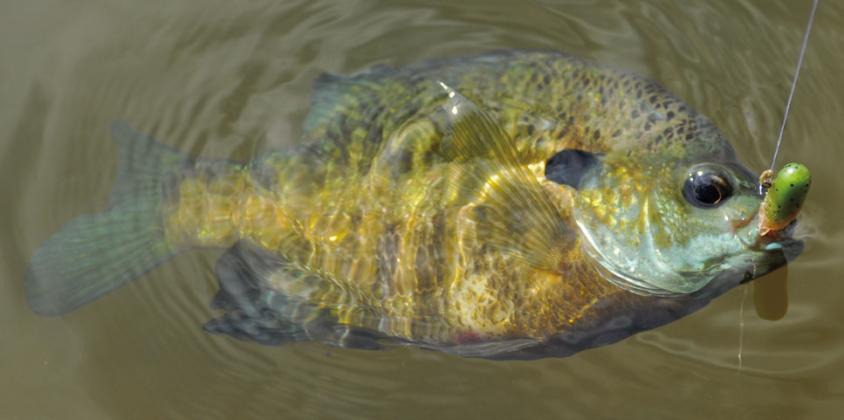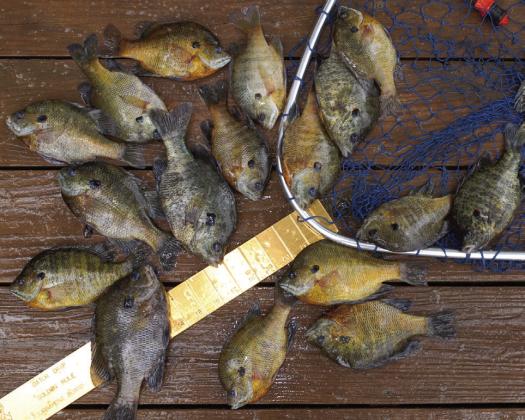Pint-sized sunfish provide fast action and great table fare for summertime anglersbass
The Great Outdoors
LAKE KURTH — It was a beautiful sight, one that any pan fisherman would truly appreciate.
Bream beds — close to two dozen of them — were stacked side-by-side on a tiny point shrouded in about three feet of water almost clear as vodka.
Dark in color and circular in shape, the “colony” of spawning beds stood out like an aquatic honeycomb in stark contrast to the sugar sand bottom. The water was so still and clear I could make out the mussel shells and small pea gravel lining in each bed from 30 feet away.
Things were bustling down there, too. Big sunfish, some that looked to be 6-7 inches long, were riding shotgun over individual nests like turkey buzzards on a road kill.
Crash Course on Bream Just about any panfish junkie is sure to agree there is plenty to love about this picture.
Though bream may be small, they may be brawniest little fighters on the planet. The pint-sized sunfish are willing to cooperate just about any time, but are easiest to catch in numbers during the summer months, while they are spawning.
The panfish are among the last to move shallow to spawn in Texas waters. May and June are sometimes touted as the best months to fish for them, but the truth is bream will spawn off and on all summer long.
Bream spawn in “colonies” that may consist of as few as 15 spawning beds to as many as 100 or more. Spawning beds usually show up on gravel or shell bottoms, often in relation to a point, hump or shelf located in close proximity to deeper water.
Colonies of spawning beds are easy to spot if you know what to look for. Spawning beds will resemble large serving plates that appear lighter or darker than the surrounding bottom.
The circular-shaped nests are usually stacked relatively close to one another. Think Swiss cheese to get a visual.
If the water is clear enough to see the beds, you will be able to tell pretty quick if there is anyone at home or not. Bream will swarm around active spawning beds.
They can be super aggressive towards something perceived as an intruder, too. Just try not to get go close. Spawning fish in clear water are prone to be spooky at times. Especially after they have seen an onslaught of fishing pressure.
Another cool thing about sunfish is just about every water body has them, often in significant numbers. Size is no barrier, either. Even small stock tanks hold some magnum-sized bream.’
Going For Bream Small jigs cast on spinning gear are deadly on sunfish. My favorite set up is a lightweight spinning rod is matched with an equally small reel that is filled with 6-pound test line. The rig launches a small lure extremely well. Plus, it adds to the challenge when a hand-sized bruiser, or something larger, grabs hold of the bait.
The prolific panfish also is a favorite with fly fishing enthusiasts. Most will agree that some sort of small popping bug of nymph is the most deadly bait, though select sub-surface lures will work as well.
Perhaps the most traditional way to catch bluegills is with a standard hook, bobber and natural bait such as an earthworm, cricket or grasshopper. Many of us got our introduction to fishing that way. Just call it a boyish rite of summer that ranks as the best training drill for youngsters new to the sport.
The rod is the heart of any bream fishing set up. I like a 13-14 foot Black Widow. The pole is lightweight, so it is easy to handle. Plus, it telescopes so it can made ready for action or storage in a matter of seconds.
The pole has a single line tie at the tip. Guides and a small reel can be added if you want, but it really isn’t necessary. A strip of 4-pound test mono the length of the pole allows for covering plenty of water sufficiently.
IThe biggest mistake beginning bream fishermen make is using too large of a hook and bait. Remember, you aren’t fishing for Moby Dick. Sunfish have small mouths, so you need to use a combination they can inhale easily.
I like a long shank hook with a narrow bite. The long shank allows for easier removal in case the fish gets hooked deep.
A small bait always works best. Rather than globbing an entire earth-worm onto the hook, pinch off a small piece and thread in on. One carton of worms should last for multiple fishing trips, provided you keep them refrigerated when not in use.
Another key ingredient of a good long-pole rig is the cork. Use a float the fish can pull under easily.
One of the best around is the Shy Bite by Thill. The float is made from balsa wood and attaches to the line using two rubber grommets.
It is a good idea to affix a small split shot to the line between the hook and the float. This will cause the float stand erect in the water and make it easy to detect the subtle bites that sometimes occur when a bream comes calling.
Great for the Skillet Sunfish aren’t just fun and easy to catch. They are also super in the skillet when rolled in a good seasoning and fried up whole until golden brown.
It takes at least a half dozen to make a man-size meal. Complimented by fried potatoes, fresh garden onions and sliced tomatoes, fried bream make an entree befitting of a king. Size Matters A bream large enough to completely cover a grown man’s palm is considered the benchmark for a big one, but they have been known to grow larger, especially on private waters where easy meals are al- ways available.
The redear is genetically programmed to grow larger than its cousins. The Texas state record redear from public waters was caught from Lady Bird Lake. It measured 14 inches long, but was not as heavy as you might think. The fish weighed 2.99 pounds.
The state record redear from private waters is 3.25 pounds. That fish was 14.25 inches long.
Bluegills, longear and redbreast sunfish are equally common in Texas waters, but fish weighing upwards of one-pound are pretty rare. A two-pounder is a giant.
Small as they are, panfish fans have learned not to be fooled by the bream’s meager dimensions.
What they lack in size they make up for in grit. In fact, ounce for ounce, the colorful sunfish rank among the hardest fighters swimming in freshwater.
------ Matt Williams is a freelance writer based in Nacogdoches. He can be reached by e-mail, mattwillwrite4u@yahoo.com.




